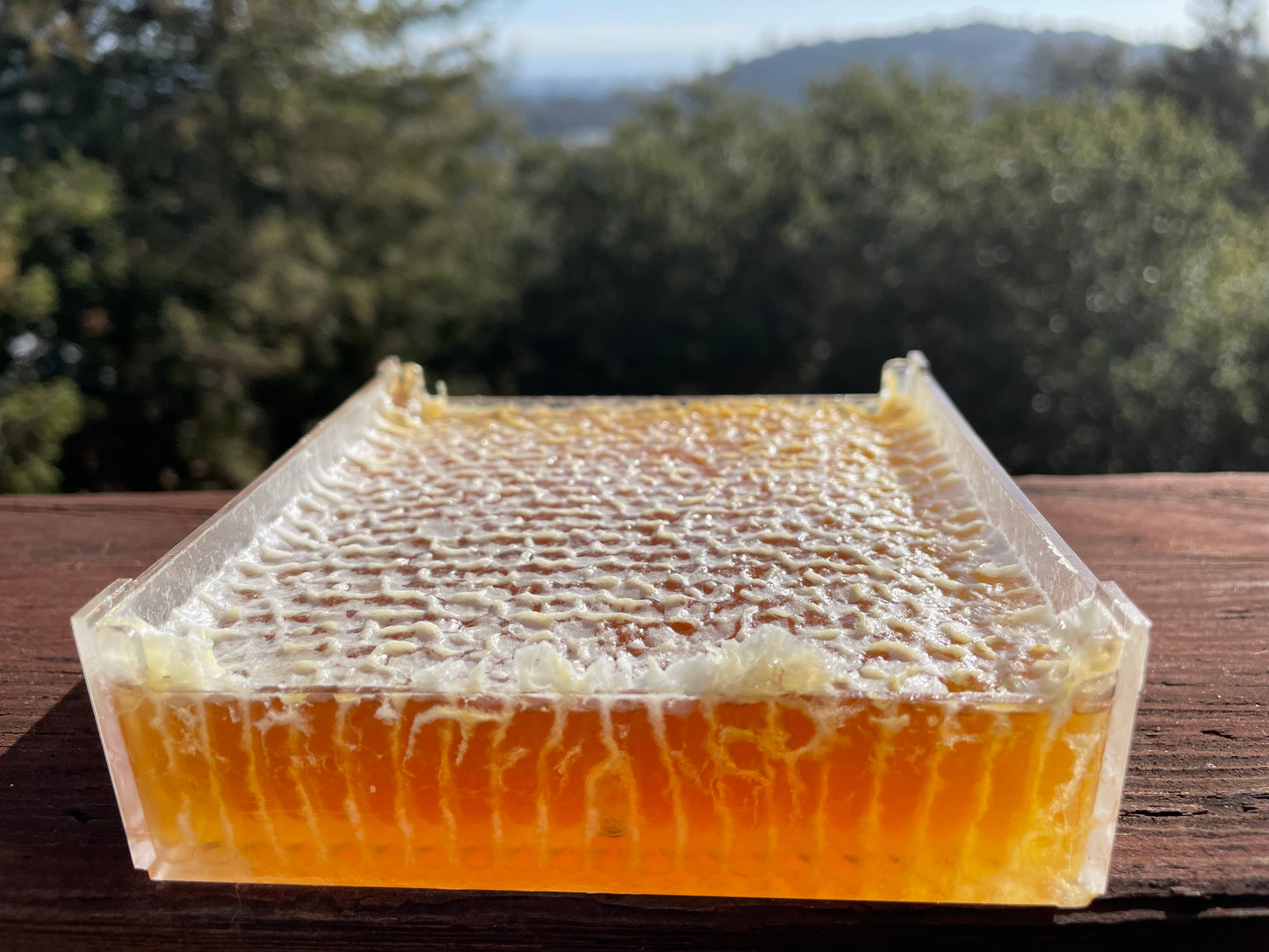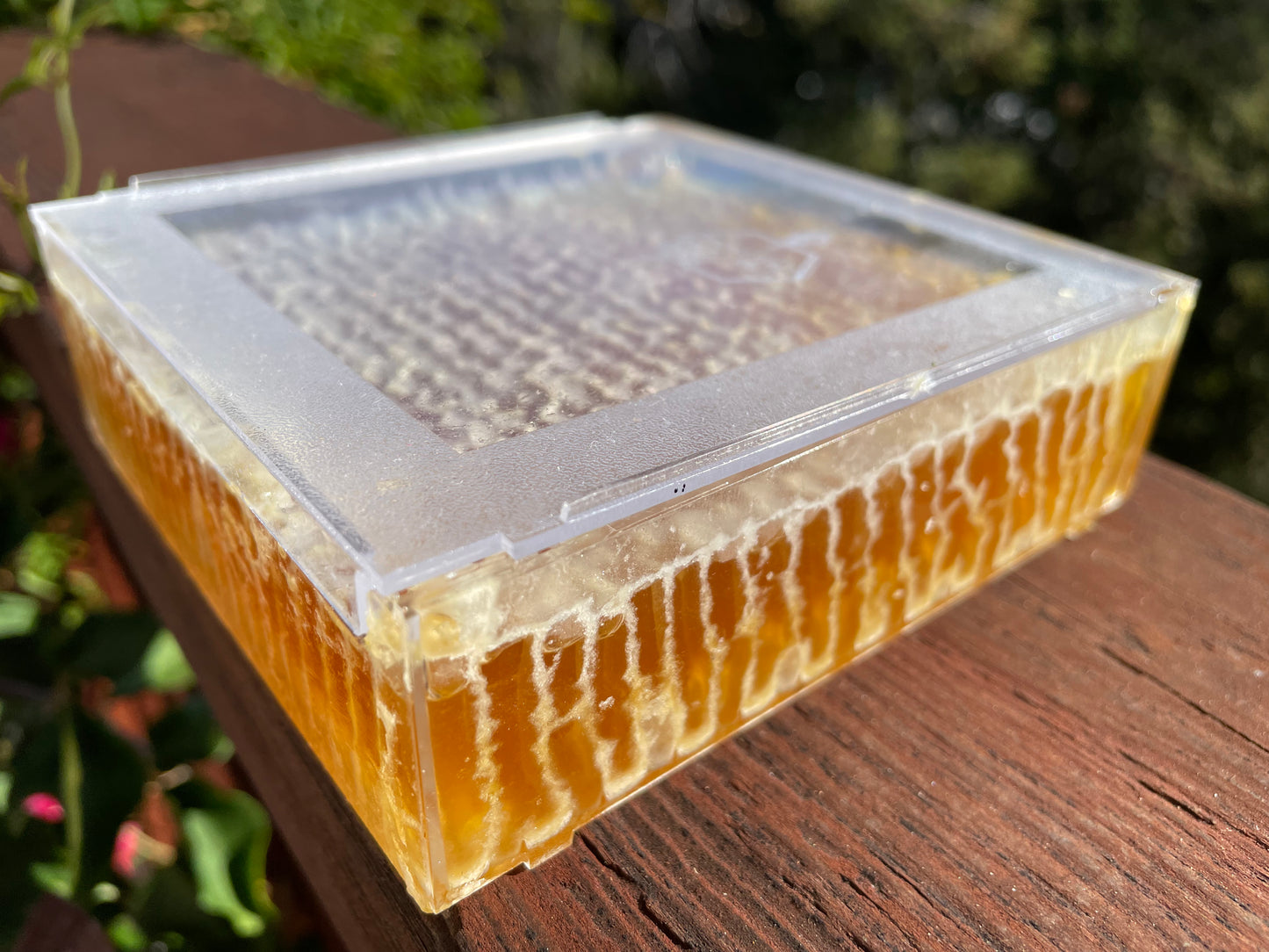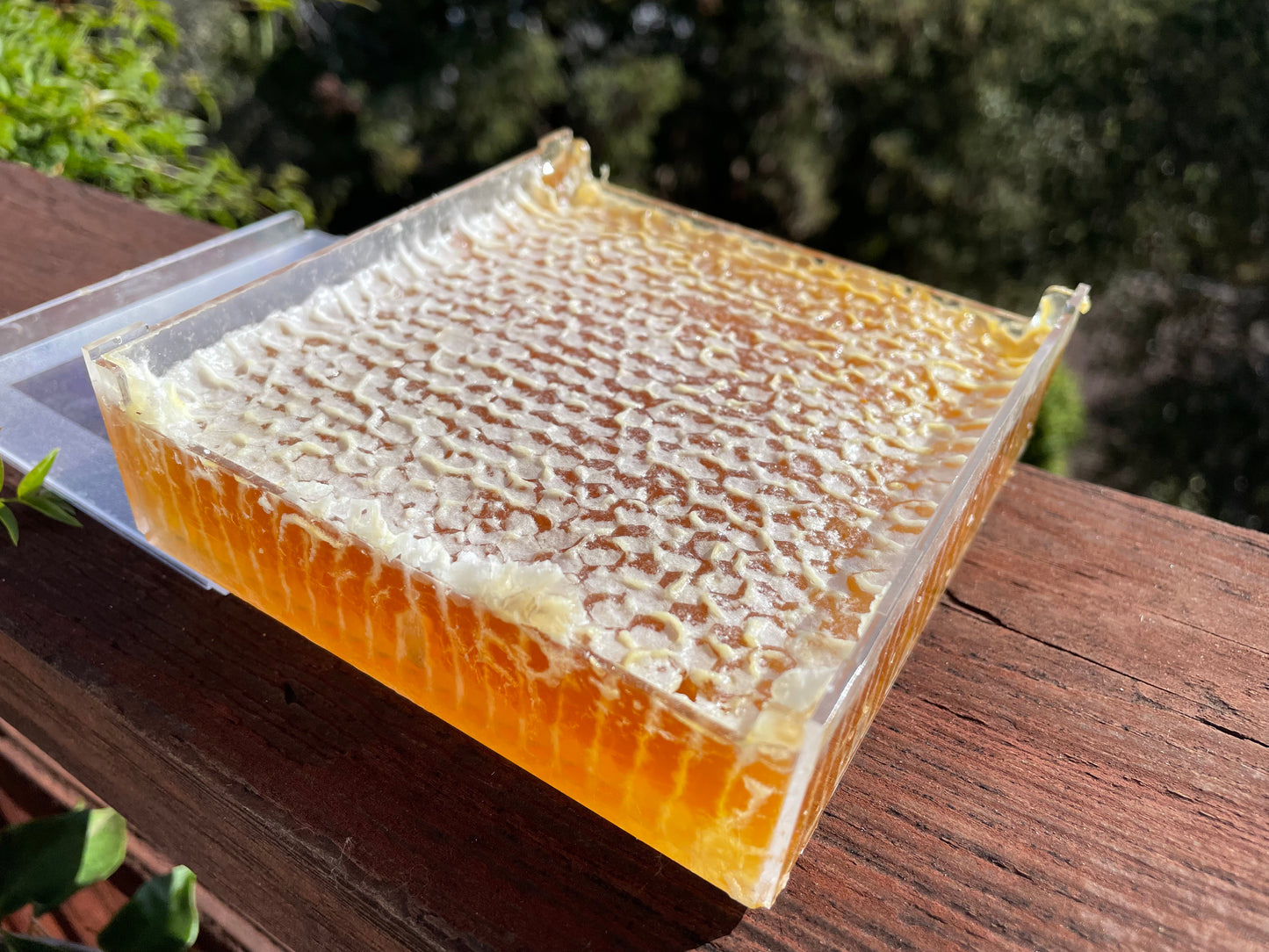Awaiting Our Next Harvest
We are currently out of stock on all honey products for the season. While we share in your disappointment, we are also filled with excitement for the upcoming season. Our bees are diligently collecting fresh nectar, heralding a promising harvest expected around June-July 2024. To ensure you don't miss out on our fresh harvest, we encourage you to subscribe to our email newsletter. Through it, we'll announce the availability of our new season's honey, both in jars and combs. Thank you for your support and understanding as we eagerly anticipate sharing the fruits of our bees' labor with you once again.
About Our Comb Honey
Our comb honey comes directly from the beehive the way the bees built it and filled it with honey. We place the comb honey container in the center of our beehive, and our bees build the comb, fill it with fresh nectar that they turn into honey.
The Flavor of Comb Honey
Comb honey boasts a distinct and delightful flavor that captures the essence of nature's sweetness. With every bite, you'll experience a mix of flavors that come from the various flowers the bees collected nectar from. From wildflowers to clover and herbs, the taste changes with the seasons. The untouched quality of comb honey ensures each bite offers an authentic experience, taking you right to the hive and the surrounding landscapes. The hexagonal comb structure enhances the flavor journey, allowing you to enjoy the honey in its purest form – a result of dedicated beekeeping and the bees' hard work.
What is Comb Honey?
Comb honey is the most unprocessed form of honey, a product directly from the beehive. It's essentially honey in its original packaging – the beeswax comb built by honeybees. The bees collect nectar from flowers, which they then transform into honey through fermentation and evaporation. In the case of comb honey, this honey is stored by the bees in the hexagonal wax cells they create. We harvest these intact combs and package them as a delicacy. Because it's entirely natural and untouched, comb honey offers a unique flavor and texture, encapsulating the purest essence of the nectar and the bees' craftsmanship.
Is Honeycomb Safe to Eat?
Honeycomb is perfectly safe and delicious to consume. Some like to swallow the chewy textured comb, others enjoy it as gum. The comb is made by honeybees using beeswax, and the honey stored within the comb is the same honey that bees produce through the collection and transformation of nectar from flowers. When consuming comb honey, you're enjoying honey in its most original state, as stored by the bees. Just make sure the comb is from a trusted source, such as a reputable beekeeper, to ensure its quality and safety. Some people even enjoy chewing on the wax comb itself, although it's entirely optional. Overall, comb honey provides a unique and flavorful experience while being a safe and natural product to enjoy.
How to Eat Comb Honey
Our favorite and recommended ways to consume comb honey:
Comb honey & goat cheese – appetizer
Comb honey on toast – breakfast
Comb honey on its own – for the purists
Important
We have limited supply of our comb honey. If you miss it this year, you'll have to wait till the summer harvest next year.
Gluten free
No preservatives
No food coloring
No natural or artificial flavors
Taste the true essence of Belmont in the San Francisco Bay Are with our own comb honey. At Honey by the bay, we're excited to offer you a genuine flavor that reflects the thriving surroundings of Belmont. Our comb honey captures the natural harmony between local bees and the environment, resulting in a distinctive taste that embodies the spirit of our community.
By choosing our local comb honey, you're not only enjoying a unique culinary experience but also supporting Belmont's ecosystem. Each spoonful encapsulates the partnership between bees and local flora, delivering a delicious outcome that's deeply rooted in the land.
Our local comb honey encapsulates Belmont's essence. With each bite, you're savoring a taste that's as authentic as our city itself. It's more than just a treat; it's a tribute to Belmont's richness and the remarkable role that bees play in enhancing its sweetness. Discover the genuine flavors of Belmont through our local comb honey, and relish in the authenticity of this local gem.
Explore our selection and embrace the wonders of unfiltered honeycomb today.
When it comes to natural sweeteners, comb honey stands as an untouched gem, straight from the hive. In this article, we're taking a closer look at comb honey from a practical and scientific perspective. We'll break down its structure, weigh its pros against liquid honey, consider its potential health perks, examine how it's enjoyed, and uncover why honeycomb is so critical in the making of honey.
The Blueprint of Comb Honey
Comb honey is crafted by the tireless bees in their hives. It's a collection of hexagonal cells, made of beeswax, housing the honey. These cells are capped with a wax seal, storing honey, pollen, and nurturing the bee larvae. The beeswax itself is a product of worker bees' glands, a blend of fatty acids and esters.
Comparing the Unprocessed Gem to Liquid Honey
The main difference between comb honey and liquid honey is how they appear. Comb honey is raw and natural, enclosed in beeswax cells. Liquid honey, on the other hand, is separated from the comb, filtered, and processed before it's ready for consumption.
Exploring the Nutritional Side of Comb Honey
Like its liquid counterpart, comb honey brings potential nutritional value. It contains natural enzymes, antioxidants, and nutrients that could offer antibacterial and anti-inflammatory effects. Because it's unprocessed, it might carry a more concentrated nutritional profile. However, just like any natural sweetener, moderation is key to reaping its benefits.
Unraveling the Ways to Enjoy Comb Honey
How you consume comb honey varies widely. Some folks opt for the rustic experience of eating the entire comb, including the wax. Others choose to chew the comb, extracting the honey and spitting out the wax. Alternatively, you can use the comb as a natural sweetener, placing it on foods or dissolving it in warm drinks. The method you choose is personal and offers a range of tactile and taste experiences.
Why Honeycomb Matters in the Honey Journey
Honeycomb plays a vital role in honey production. Beeswax, formed by bees' abdominal glands, is shaped into hexagonal cells to create the comb. These cells serve as storage units for honey, pollen, and the young bees. Constructing and maintaining the honeycomb is integral to the hive's survival.
Decoding the Honeycomb Dilemma
A common question is whether to eat or avoid the honeycomb. The answer depends on preference and the quality of the comb. Honeycomb is indeed edible, containing honey and potential nutrients. Some enjoy the texture of eating the whole comb, while others might find it less appealing. Chewing or ingesting the wax is generally safe, allowing you to savor the honey.
Embracing Culinary Adventures with Comb Honey
The journey of comb honey extends to culinary traditions worldwide. In certain cultures, comb honey is enjoyed as is, while others pair it with foods like cheese or bread. Its culinary flexibility makes it suitable for both refined dining and everyday meals. Here are a few ideas for inspiration.
1. Honey and Cheese: A Match Made in Gastronomic Heaven
Comb honey and cheese share an intricate dance of flavors, where the sweetness of honey harmonizes with the richness of cheese. Pair a chunk of honeycomb with your favorite cheese varieties like creamy Brie, tangy goat cheese, or aged cheddar. Spread the honeycomb on crackers or crusty bread to create a balanced blend of sweet and savory. The contrast in textures and taste profiles offers a palate-pleasing experience that's simple yet unforgettable.
2. Breakfast Elegance: Honeycomb and Morning Fare
Elevate your morning routine by introducing honeycomb to your breakfast spread. Drizzle honeycomb over yogurt or oatmeal to infuse a natural sweetness and a touch of earthiness. Spread it on warm toast, letting the honeycomb melt into a delectable topping. The burst of flavors and the visual appeal of honeycomb will transform your breakfast into a culinary masterpiece.
3. Salad Sensations: Honeycomb as a Flavor Enhancer
Incorporate honeycomb into your salads for a burst of sweetness and textural intrigue. Toss chopped honeycomb into mixed greens or grain salads to introduce an unexpected element. The subtle notes of honey from the comb will dance alongside the fresh ingredients, creating a harmonious balance that delights the senses.
4. Honeycomb Glaze: A Gourmet Delight
Take your culinary adventures to the next level by crafting a honeycomb glaze. Melt the honeycomb down and mix it with complementary ingredients like citrus zest, herbs, or spices. Brush this glaze over roasted meats, vegetables, or even as a finishing touch on baked goods. The marriage of honeycomb's natural sweetness and other flavors will tantalize your taste buds and impress your dinner guests.
5. Artisanal Desserts: Honeycomb as a Focal Point
In the realm of desserts, honeycomb shines as a star ingredient. Incorporate chunks of honeycomb into ice cream for delightful pockets of sweetness. Drizzle melted honeycomb over cakes, tarts, or crepes for an earthy and luscious touch. The dynamic presence of honeycomb turns ordinary desserts into artisanal creations that celebrate the richness of nature.
6. Honeycomb Beverages: Crafting Unique Drinks
Expand your culinary explorations to beverages by infusing honeycomb into your drinks. Dissolve honeycomb in warm water to create a soothing honey elixir. Stir melted honeycomb into tea or cocktails for a distinctive flavor profile. The versatility of honeycomb as a drink enhancer adds layers of complexity to your sips.
7. Baking Brilliance: Honeycomb in Breads and Pastries
Baking enthusiasts can incorporate honeycomb into their creations for an exquisite twist. Fold finely chopped honeycomb into bread dough for a subtle sweetness and delightful chewiness. Layer honeycomb between puff pastry sheets for a unique filling that adds depth to pastries.
8. Exotic Honeycomb Pairings: A Global Gastronomic Journey
Explore international flavors by combining honeycomb with exotic ingredients. Pair honeycomb with Middle Eastern tahini for a marriage of sweet and nutty. Experiment with Indian spices like cardamom or saffron to create fusion treats that intrigue the palate.
Unraveling the Science of Comb Honey
As we conclude our exploration of comb honey, we've dissected its scientific aspects, potential health benefits, and various ways to enjoy it. Comb honey showcases the intricate relationship between bees and their environment, resulting in a unique honey variant that engages the senses and carries potential nutritional value. Whether you prefer to chew the comb, dissolve it in your tea, or savor it as nature intended, comb honey invites you to appreciate the resourcefulness of bees and the bounty they provide.
In a world dominated by processed foods, comb honey shines as a reminder of nature's balance. Its potential nutritional value, connection to the bees' efforts, and insight into the honey-making process make it a valuable addition to any pantry. While its potential health benefits are appealing, remember that moderation is crucial. Whether you focus on the honey or include the comb, let each bite honor the scientific wonder of comb honey—one cell at a time.






